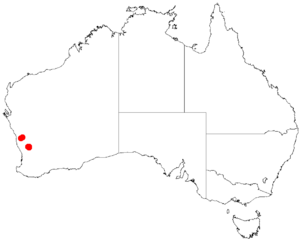Wongan wattle facts for kids
Quick facts for kids Wongan wattle |
|
|---|---|
| Conservation status | |
| Scientific classification | |
| Genus: |
Acacia
|
| Species: |
semicircinalis
|
 |
|
| Occurrence data from AVH | |
Acacia semicircinalis is a special kind of shrub often called Wongan wattle or Wongan sprawling wattle. It belongs to the Acacia family. This plant grows only in a small part of western Australia. It used to be on the list of threatened plants, but it was removed in 2006. This means it is not as endangered anymore.
What Does Wongan Wattle Look Like?
This shrub is usually thin and spread out. It can grow from about 0.3 to 1.0 meter (1 to 3 feet) tall. Some plants grow close to the ground, while others stand more upright. Its branches are light to reddish-brown and can spread out.
The Wongan wattle blooms from August to January. During this time, it produces bright yellow flowers. These flowers grow in round clusters, with about 25 flowers in each ball. They appear alone or in pairs where the leaves meet the stem.
After the flowers bloom, the plant grows seed pods. These pods are long and thin, sometimes slightly curved. They are about 6 centimeters (2.4 inches) long and 6 millimeters (0.24 inches) wide.
How Was Wongan Wattle Named?
The Wongan wattle was first officially described in 1927. Two botanists, Joseph Maiden and William Blakely, gave it its scientific name. They wrote about it in a scientific paper.
Later, in 2003, another botanist named Leslie Pedley changed its name to Racosperma semicircinale. However, in 2005, it was changed back to its original name, Acacia semicircinalis.
Where Does Wongan Wattle Grow?
The Wongan wattle is found only in a small area of the Wheatbelt region in Western Australia. This means it is endemic to that area, growing naturally nowhere else. It often grows on hillsides in gravelly soil.
It has a very limited range, mainly in the Wongan Hills area. Scientists think it grows well in places that have been disturbed, like after a fire. It is also known to live for a long time.
You can often find Wongan wattle growing with other plants. These include different types of Mallee trees and other Acacia shrubs. Some common plant neighbors are Allocasuarina campestris, Petrophile shuttleworthiana, Eucalyptus longicornis, Acacia acanthoclada, Acacia lasiocarpa, and Acacia pulchella.
In 2006, experts estimated there were about 10,400 mature Wongan wattle plants. These plants were found in fifteen separate groups. They covered an area of about 60 square kilometers (23 square miles).


